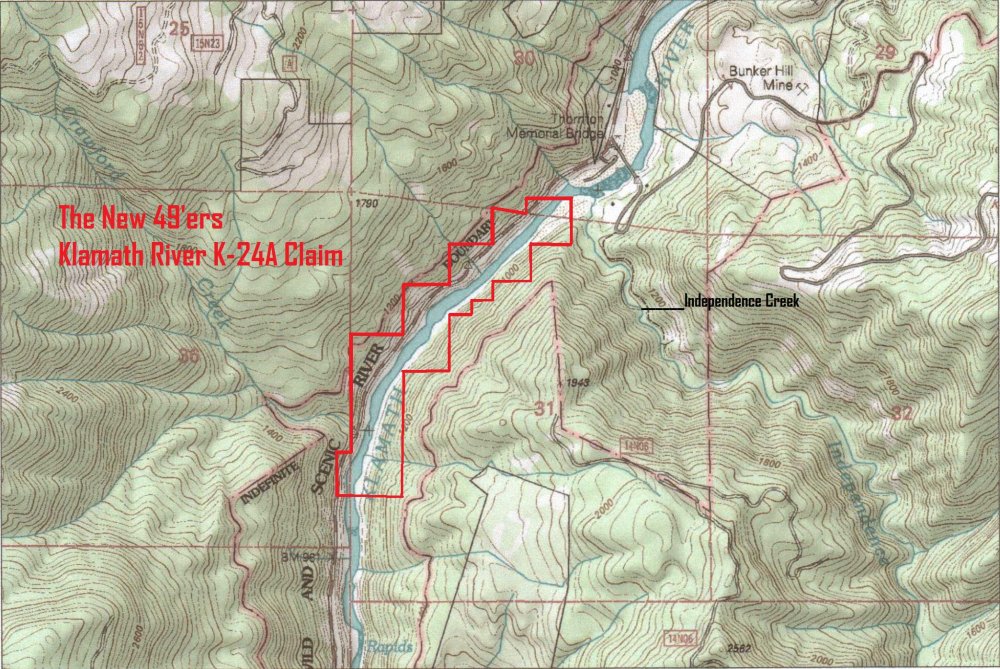
FIRST QUARTER, January 2013 VOLUME 27, NUMBER 1
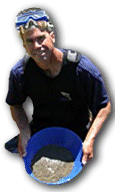
By Dave McCracken
This discussion began on our Internet Forum where I announced that we have recently acquired the richest dredging claim along the Klamath River near Happy Camp, which will also provide some fantastic surface and underwater crevicing opportunities because of the gentle slope of exposed bedrock which is extending off the side of the river where the gold path is located (more on the new claim below).
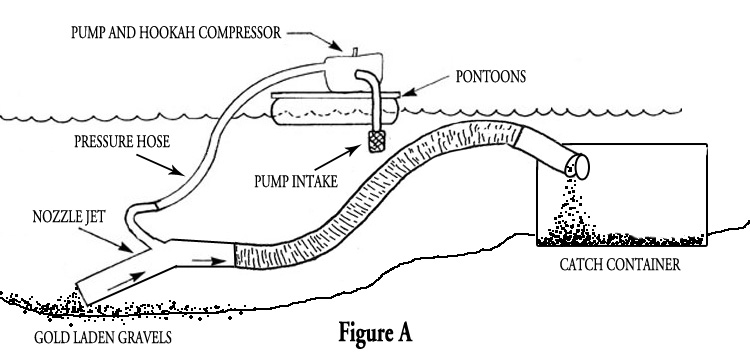
Motorized underwater suction mining in California without a “dredge!”
In my announcement, I pointed out that there is nothing in California’s dredging moratorium that prevents us from crevicing underwater using a motorized hookah air system, or even using a water pressure nozzle to help blow gravel out of cracks. The question I posed to our forum members is how to get the gold up and into a catch container without using a suction dredge.
It would be one thing if we were just uncovering an occasional gold nugget or two. We would simply free those up with some hand tools and pick them out with a set of tweezers. But I have seen crevices on this particular mining property that were loaded with a zillion pieces of gold, much of it in fines and flakes. You have to suck that up, or you will be there all year with a pair of tweezers! The original claim owners were recovering six and seven-ounce days (sometimes more) in places along this claim. They were only in there a few years before they retired. Since they operated an 8-inch dredge, they remained towards the lower end of the property where the water is deeper and slower. There is at least a half-mile stretch of faster, shallower water on the upper portion of the claim that, to my knowledge, has never even been sampled. This is the area I believe will make for good above and below water crevicing.
In response to my question, one of our more informed members and longtime supporter, Jim Foley, sent me a copy of the California Department of Fish & Game’s (DFG) current suction dredge regulations which clearly state that “A person is suction dredging as defined when all of the following components are working together: (A) a hose which vacuums sediment from a river stream or lake; and (B) A motorized pump; and (C) A sluice box.” The regulations further state, “Every person who operates the suction nozzle of any suction dredge shall have a suction dredge permit in his or her immediate possession.” These regulations were formally adopted in California on April 27, 2012.
The existing moratorium in California prevents DFG from issuing suction dredge permits. We are strenuously challenging the moratorium in several jurisdictions. Until our challenges are resolved, it is unlikely that we can operate suction dredges as defined by the regulations without being cited. Since most of us don’t want to be in trouble with the authorities, we have been doing our dredging in southern Oregon for the past few seasons.
But looking closer at the California regulations, there does remain a way for us to go down on the bottom of California’s waterways and suction up the shallower, higher-grade gravels. This is because, as defined by DFG’s own formal regulations, as long as we remove the sluice box from our motorized suction system, we are not operating a “suction dredge.” Said another way, there is an opportunity to use a motorized suction system to transfer high-grade gravel from one place in the river or creek to another location where the gravel can be more-easily processed in a separate system.
I am in possession of written communication from a high ranking DFG official, the very person who was in charge of developing the current regulations, which acknowledges that underwater suction-powered gravel transfer would not be considered “suction dredging” as long as the sluice box is removed from the system. He also cautioned that there are water quality concerns and also streambed alteration considerations. So there would be some limits involved. I’ll discuss these more in a minute.
For now, let’s just get back to my original discussion about using a hookah and motorized pumping system to expose and recover gold from very shallow deposits out in the river. I’m not talking about shallow water. I am talking about shallow streambed material on top of underwater gold deposits.
Here is just one of several ideas: Please see Figure A above. If I completely remove the sluice box from my 5-inch dredge, I am left with a floatation system which supports twin 6.5 HP Honda motors and pumps with a hookah compressor. I could use a single motor & pump with compressor to power a 3 or 4-inch Hydro-Force nozzle jet. This special nozzle will allow me the option to blow off lighter gravel to expose cobbles, which I can then move out of the way by hand, just like we do in dredging. This will allow me to work my way down to the pay-dirt without having to suck up any gravel. Once I expose the pay-dirt, a Hydro-Force nozzle will allow me to suck it up and transfer it over to a catch container in shallower, slower water which is closer to the bank.
If there is some distance involved between where I am prospecting and my catch container, I can use my second engine & pump to provide power to a booster jet attached to a second 3 or 4-inch hose (See Figure B). Since the whole suction system would be underwater, I’m guessing that would give me a reach of fifty feet or more. In case you are interested, Montine in our office can help you acquire Hydro-Force nozzles and booster jets for these kinds of systems – and maybe soon there will be baffled catch containers: 530 493-2062.
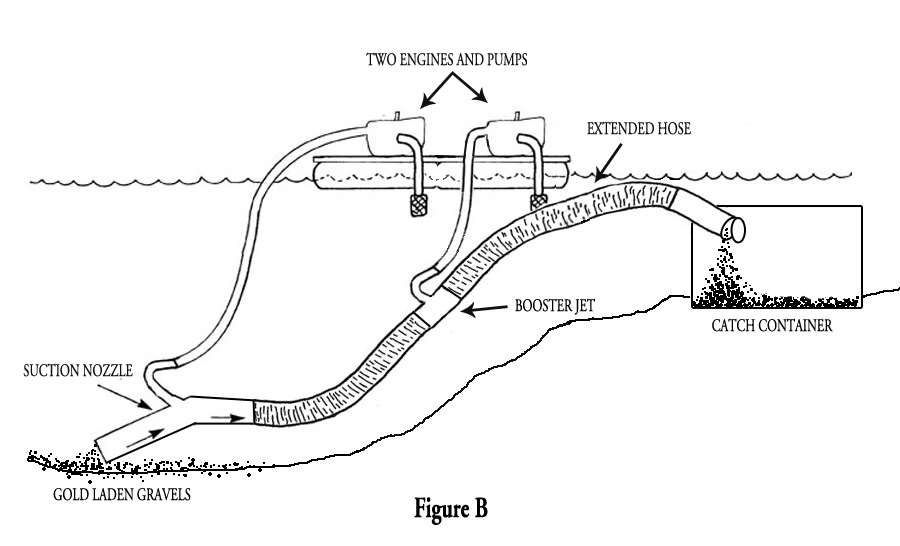
The catch container would need to be large enough to accumulate the amount of pay-dirt that I would suck up on a single dive. My suggestion would be to fabricate a baffle on the feed into the container so the material would be deposited there neatly. Otherwise the water flowing out of the suction hose might boil the material out of the catch container.
If you make smart use of the blower function on the Hydro-Force nozzle, you can really minimize the amount of gravel that you transfer by suction to the catch container; perhaps so little that you can work it all down and recover your gold between dives with just a classification screen and gold pan.
If there is more non-gold bearing material present than you can blow off with the Hydro-Force nozzle, you would always have the option of sucking that off separately and depositing it outside of your catch container.
Several experienced prospectors I have spoken to about this had other ideas. One suggested fabricating the catch container between the pontoons on his floating platform. Then he could just float it over closer to the bank to pan the material after each dive. Jim Foley, who has already experimented with the idea, says he successfully attached a 20-foot piece of PVC plastic tubing to direct the discharge into a catch container that was sitting up on the streambank. This took place in the fall of 2012. Jim was visited by local game wardens while doing the activity. And while they expressed reservations (“sure looks like a dredge”), he was not cited and the wardens did not return.
While I’m sure we will learn more as we gain experience, here are a few of my own thoughts on “underwater suction gravel transfer systems:”
1) Make certain to not have the sluice box from your original “suction dredge” anywhere in the vicinity of the program. DFG regulations prevent you from having a “dredge” within 100 yards of any active waterway. Therefore, that third component (sluice) should not be sitting up on the streambank or even in the back of your pickup truck, even if you are not using it. Leave it at home!
2) Do not direct the discharge of your suction system into some other type of recovery system that uses a sluice box. Using any sluice in combination with the suction system, all working at the same time, would likely meet the regulatory definition of a “dredge.”
3) There has been some suggestion that even sluicing the recovered gravels at some later time would fulfill the definition of a dredge. You guys can make your own decisions about this, but I’m not buying the theory. The language in the regulation defines the three components working together. So it would seem reasonable that you could shut your underwater suction transfer system down and then separately process the gravel in any normal way that does not violate water quality standards. Though I would not be using the sluice that I took off my suction dredge, or any sluice which could be attached to the suction system. Be advised that you will be on thinner legal ground as soon as you have any sluice as part of your program within 100 yards of the suction system. Personally, I am inclined to carefully suck up a lower volume of only the highest-grade material and use a gold pan to work that down between dives (more on this below).
4) I would not suck a bunch of silty material into a catch container that is sitting in dead water alongside the bank. That might provoke water quality concerns. This is why I suggest using the blowing option on the Hydro-Force nozzle to first free up material out under the moving water. Gold is heavy. It won’t blow away if you pay attention to what you are doing.
5) I also would not advise using this system to make large excavations out in the creek or river. That might provoke streambed alteration concerns. I would use this method to work shallow deposits much the way we do in high-banking. Having said that, it has also been pointed out that the existing suction dredge regulations clearly state that there would be no requirement for a stream alteration permit, and there would be no deleterious impact upon fish, from the use of 4-inch suction dredges in California’s waterways. So it would seem unreasonable for DFG to make a stream alteration argument if you are careful about not making large excavations.
6) I would advise the use of rigid pressure hose between the pump and nozzle jet(s) on this type of system. It is difficult enough to keep the kinks out of lay flat pressure hose outside of the waterway.
7) Since initially, DFG wardens may not be aware of their own formal definition of a “dredge,” I suggest you print out at least the first page or two of the regulations which include the formal definition of a “dredge,” and have them available if and when any officials come around to see what you are up to. Make sure to point out the complete absence of a sluice on your suction system. And whatever you do, never refer to this activity as “dredging.” Because it is not dredging! It is an underwater suction system used to direct small volumes of high-grade material into a catch container. Nothing more. If you tell the warden you are “dredging without a sluice box,” you will probably provoke a citation, the warden telling you to explain it to the judge!
8) If any citations are written for this non-dredging underwater form of prospecting, please get in touch with us without delay. We may want to become involved with your defense.
Conclusion: I can process material through a “suction dredge” about as fast as anyone I know. Yet, my tailings do not amount to much at the end of my dives. This is because most of the underwater work has to do with freeing and moving oversized material out of the way (rocks that are too big to suck up). Depending upon the size of the suction nozzle, perhaps as much as 95% or more of the volume has to do with rolling rocks behind me. I would normally suck up the other 5% of material into my sluice box if I were “dredging.” That volume over my sluice box gives me a substantial amount of heavy concentrates to process – which takes quite a bit of time.
But with this underwater gravel transfer system, I can easily visualize how I can blow the lighter material out of my way and only suck up the pay-dirt. This would dramatically reduce the amount of material I will need to process out of my catch container. While the underwater process may not be as fast or efficient as “dredging,” I might make up for it by having fewer concentrates to process.
Please note my words in bold just above. They are perhaps the most important words I have said here. This is because if you suck everything into your catch container, it will soon fill up with low-grade material which may not be worth the time to process further! The whole idea in this new system is to get the low-grade material out of your way out in the river, and only suck up the very small volume which is directly associated with a gold deposit. Gold deposits are nearly always located in a contact zone. This means either on the bedrock, between storm layers, or on top of the upper layer of hard-pack. There is an entire education about this in the articles at this link. If you still need help understanding this, you should attend one of our weekend group mining projects and allow us to show you exactly what you are looking for!
Using this system to discriminate carefully about what you suck up will accomplish two important objectives:
A) You won’t find yourself up on the bank most of the day panning a bunch of gravel that doesn’t have much gold in it.
B) You will only use the suction system to recover a very small volume of material – only that which contains the gold. Using this as a small volume tool to help with your crevicing program will give anti-mining activists less to complain about.
There has been quite a lot of debate about this “underwater suction gravel transfer” idea on the Industry Internet forums since I have gone public with it; and finally, someone asked Mark Stopher of DFG for the straight scoop:
Here are the official answers (2 January 2013): “I carefully read (today) the information that McCracken provides on his website. I believe Dave McCracken’s description of the legal requirements and application of the regulations is accurate. If practiced as he describes, this is not a violation of the moratorium and is not prohibited.
There is no specific permit required and no seasonal restrictions. Since this is not suction dredging, neither the moratorium or our adopted regulations for suction dredging apply. It’s essentially a loophole in existing law. However, as McCracken notes, Fish and Game Code section 1602 could apply if the streambed alteration is substantial, that is, you create a big hole. My guess is that such a system will be less efficient, and less excavation will occur, than if you were using a suction dredge since there is no sluice box and miners will need to use some other system to sort through the material.”
Mark Stopher
Habitat Conservation Program Manager
California Department of Fish and Game
601 Locust Street
Redding, CA 96001
This new idea will at least allow us access to some of the submerged gold deposits that otherwise would be out of our reach until the “dredge” moratorium is lifted in California. How’s that for good news?
We Have Acquired One of the Klamath River’s Richest Gold Properties!
Happy New Year, you guys! At long last, we have acquired the main stretch of gold-bearing river just downstream of Independence Creek. This Middle Independence Claim (K-24A in our Claims Guide) is located between our existing K-24 and K-25 mining properties, about 12 miles downriver from Happy Camp. This is a very rich gold property! The reason is because it contains three separate lines of high-grade gold: (1) Independence Creek has been depositing a steady line of larger, crystalline gold into the river for about a million years. One of Siskiyou County’s richest pocket mines is located about a mile up the creek. This gold has more of a crystalline texture to it; it is very unique! Over the years, we found a bunch of it on our K-25 property about 1 ½ miles downstream from the mouth of the creek. Some beautiful specimens were found down there! I am predicting that the best is yet to come off the east side of the river on this new property. (2) One of Siskiyou County’s richest hydraulic mines, “Bunker Hill,” directed its tail races into the Klamath River just upstream of this property. I personally have seen others recover 6 and 7-ounce days mining redeposited gold on the lower end of this property. The gold was resting directly on top of the bottom strata of original streambed. I am also predicting that the best is yet to come from redeposited gold in the shallower stretches of river on the upper portion of this new property. (3) The original streambed out in the river is rich, rich, rich! Most of it remains in place. It is going to be interesting to see if we can get at that with our suction gravel transfer systems in the upper, shallower deposits.
The reason I know so much about this property is because it is where the original gold dredging strike was made on the Klamath during 1984 which motivated me and others to emigrate over from the Trinity River. This property is where it all started! The strike was made by two of my dredging buddies that went over there ahead of me from the Trinity. They were just supposed to be on a sampling trip. I went looking for them when they didn’t return and found them on the lower end of this property. They had tapped into the redeposited gold resting on top of the original streambed. That was, by far, the most gold I ever saw in the four years that I had been dredging! Me, Eric Bosch, and about 30 of my students all picked up and moved over to the Klamath on the following day, and we never went back! We started The New 49’ers a few years later.
My two friends filed a mining claim on this 1.1-mile stretch of river, and it has been in private hands ever since. They recovered enough gold to retire within just a few years. Then they sold the property to a company of private individuals, most who did not do any serious mining there. Several of the more serious guys worked the lower portion of the claim with commercial dredges and did very well. The property has been sitting idle for many years. The owners never allowed others to crevice or high-bank the extensive reaches of exposed bedrock and shallow gravel bars which line the east bank of the river. That is the side from which both the hydraulic mine and Independence Creek have deposited their rich golden treasures into the river.
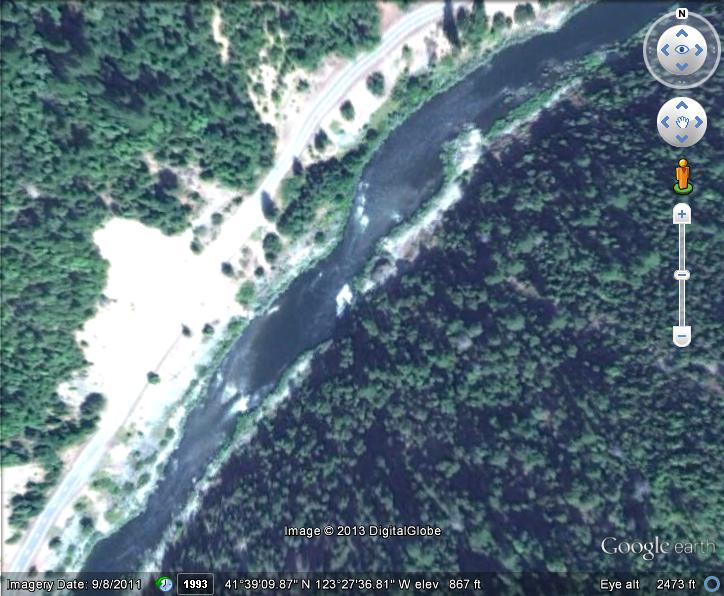 The east side of the river has extensive exposed bedrock and shallow streambed along one of the stronger gold paths.
The east side of the river has extensive exposed bedrock and shallow streambed along one of the stronger gold paths.
While there has been some serious commercial dredging activity on the lower end of the property out in the middle of the river (most of the middle still remains untouched), I have never seen anyone do anything with the shallower sections of water on the east side (right side of the river on these images). The upper half of the property has faster water, making it more difficult to operate larger sized dredges. That’s why it remains relatively untouched. That presents us with an extraordinary opportunity with these more portable “underwater suction gravel transfer systems” that I have outlined above! There is also extensive opportunity for crevice mining on the surface (vack mining), and some normal high-banking activity.
A note on this: Even though the two original owners were dredging out in the middle of the river, they confided in me that one of their wives was recovering incredible gold in the shallow deposits on the east side of the river, including the crystalline nuggets from Independence creek – and that was a mile downriver from the sources of the gold! I have also never seen anyone do any shallow dredging or surface mining along the bottom end of this extensive claim. Though, several of our members had extraordinary success just downstream on our K-25 property! Extensive bedrock gently sloping off the east side of the river will make this perhaps the best above and below water sniping and crevicing area along the Klamath River! The opportunities are endless.
Once again, I find myself looking up to the stars and wondering what we did to deserve such a gift from the heavens! This property is going to make our members happy for many years to come. Once the dredge moratorium is lifted, I can guarantee you where my dredge is going to go. Meanwhile, I plan to be out there this season with an underwater suction system as described above.
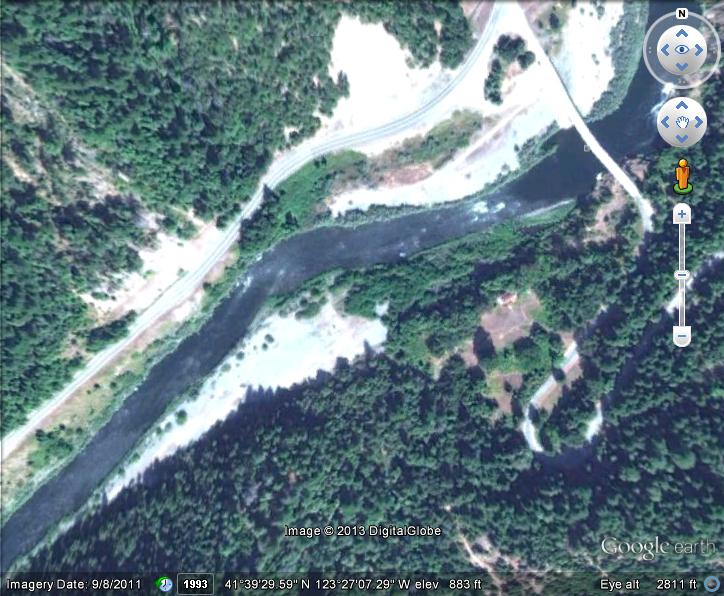 There is access to the east side of the river at the upper end of the property, just downstream of Independence Creek.
There is access to the east side of the river at the upper end of the property, just downstream of Independence Creek.
We will provide more images and information about access in the coming newsletters. You don’t see them this month because the entire area around Happy Camp took on about two feet of snow just a few days before Christmas. Happy Camp is still digging out! Meanwhile, here it is on Google Earth. With the exception of a short portion of the river between Independence Creek and the bridge just upstream, we now hold nearly three continuous miles of this very rich stretch of river!
 Happy Camp during Christmas of 2012!
Happy Camp during Christmas of 2012!
In advance, I can tell you that the best line of gold for surface mining and underwater crevicing is going to be on the far side of the river (from the road). There is going to be some rather easy access towards the upper end. This is because a bridge there will allow us to reach the other side, park our vehicles and walk down. Access further down this very extensive property will require a boat. There are several slow sections of river that will allow relatively easy crossing (small boat with motor).
This new K-24A is only one of several very rich properties we have recently acquired along the Klamath. As long as everything firms up the way it looks at the moment, I hope to announce miles of excellent new high-banking and underwater crevicing ground over the coming winter months, in addition to this new property at Independence. These new acquisitions could actually change the location of where we will conduct our Group Mining Programs this coming season.
Schedule of Weekend Projects for 2013
All members are invited to attend our weekend Group Mining Projects and keep an equal share of the gold that we recover. Here are our planned events for the upcoming season: June 1 & 2; June 22 & 23; July 13 & 14; August 3 & 4; August 24 & 25.
New Oregon Legislation Pending
Our attorney, James Buchal, has provided us with a legal analysis of LC 2125. James says, as the proposed bill is presently written, it will not affect the suction dredge activities which are already being allowed in Oregon. Having said that, James also points out that we need to be concerned that the existing language could easily be changed on its way through Oregon’s legislative process.
The analysis points out numerous reasons why the proposed bill should be opposed altogether. I have been in contact with all or most of the industry leaders inside and outside of Oregon, and I believe there is unanimous consent that we should do everything in our power to defeat the bill. It looks like the Oregon mining associations will take the lead on this.
Since the Oregon legislature goes back in session in February, you can expect to hear more about defeating LC 2125 in the weeks and months to come.
Progress in the U.S. Supreme Court!
Here is some good news: The U.S. Supreme Court is impressed enough with our Petition (to overturn a recent 9th Circuit ruling that discourages small-scale mining on the public lands) that they have Ordered the Karuk Tribe to submit a response. This at least means our Petition is being given very serious consideration.
New Legal Fund Prize Drawing
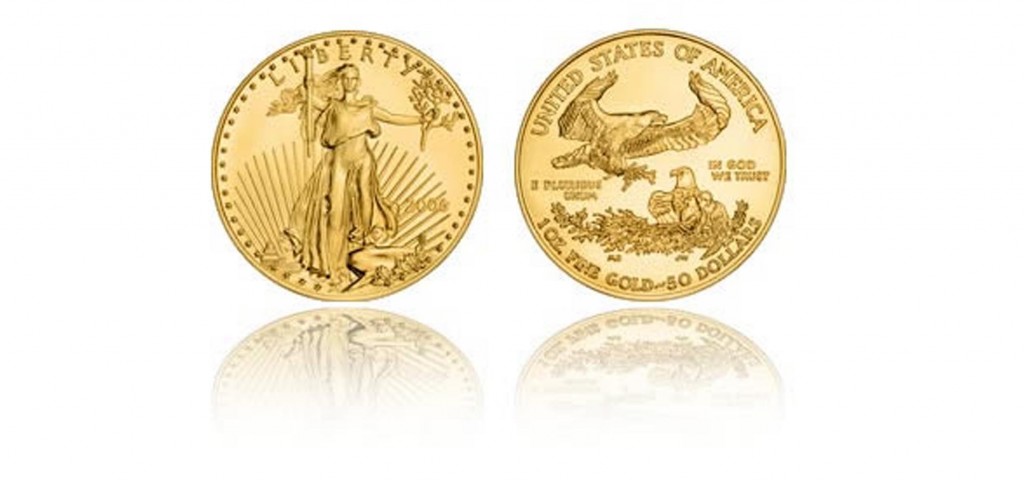
Here is a link to our new legal fundraiser. We will be giving away 15 American Gold Eagles on 8 March 2013.
This is all in an effort to raise money to support our challenge in the U.S. Supreme Court of a recent Ninth Circuit Decision which discourages small-scale mining on the public lands — and also to support our efforts in defending multiple cases in the California court system.
We greatly appreciate your support in these fundraisers!
Only About 50 Special Editions Remaining!
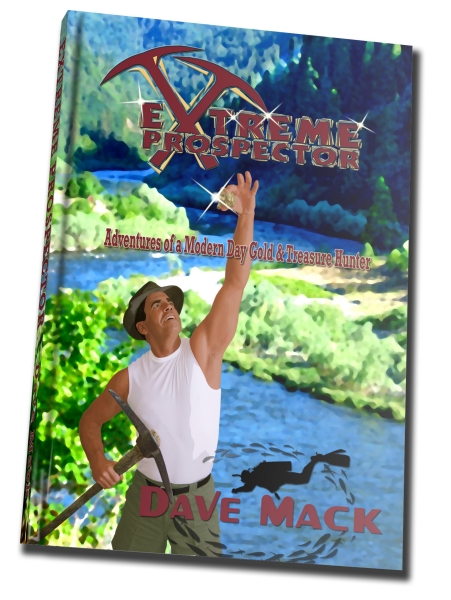
As far as I know, this is the first and only adventure book ever written which brings to light the incredible excitement of discovering high-grade gold deposits – for real. I’m pleased to say that initial reviews of the book are quite good! The book includes my very best adventures and some of my best-kept secrets, including several adventures during my time in the U.S. Navy SEAL Team.
I only signed 500 hard cover Special Editions. As a special promotion, we are making these available at the very same price of the soft cover version ($19.95). The girls in our office have been taking phone orders for several months: 530 493-2062. There are only around 50 Special Editions remaining, available on a first come, first served, basis.
“Extreme Prospector,” is also available as an ebook from Amazon for half the conventional book price ($9.95). As an Internet download, most of the images come through in color (about 250 of them) and the hyperlinks work. You can find the ebook, along with normal soft and hard cover versions of the book, right here.
Please Join Me on Facebook and Twitter!
With the launch of Extreme Prospector, I have started up a blog which broadens the context to ongoing adventures and other important news and issues that we are all facing today. These include discussion and links to informative information about the economic realities of our time. Important stuff!
My latest blog released the news about this new “motorized underwater suction mining” concept weeks before you are seeing it in this newsletter. I provide updates in the blog as soon as I am aware of them.
If you are interested in up-to-date news, along with stories about extreme prospecting adventures (not just mine), I invite you to visit my Facebook page at facebook/DaveMackExtreme and follow me on Twitter @DaveMackExtreme. There is a “Free eBook” tab on my Facebook page where you can download Chapter 10 of Extreme Prospector.
I hope a bunch of you guys and gals will join me up there and encourage all of you to join in the discussion and “Like” my page to share with your friends.
Lost Treasure Hunters on Youtube!
For any of you guys who missed our first episode of Lost Treasure Hunters on Animal Planet, it is now playing on youtube. Check it out!
Sign up for the Free Internet Version of this Newsletter
We strongly encourage you to sign up for the free on line version of this newsletter. The Internet version is better, because you can immediately click directly to many of the subjects which we discuss; because the on line version is in full color; because we link you directly to locations through GPS and Google Earth technology; and because you can watch the free video segments which we incorporate into our stories.
Signing up also places you on our Political Action Team. Things happen so fast these days; it takes too long to organize political action through the U.S. mail. As an example, just two years ago, in concert with other mining organizations, our Internet Action Team killed anti-mining legislation in Oregon in less than a week. It is a near guarantee that we will be calling for industry-wide action to defeat this new legislation being proposed in Oregon before you even see another of these newsletters. All of these future battles will be organized over the Internet since it is so much faster. Please join us in the battle to maintain our remaining freedoms!
Sign up for our Free Internet Newsletter!
The New 49’ers Prospecting Association, 27 Davis Road, Happy Camp, California 96039 (530) 493-2012
www.goldgold.com


